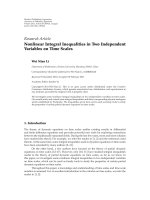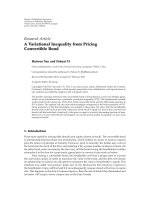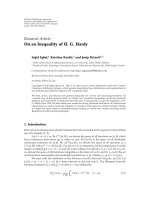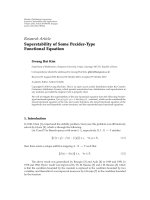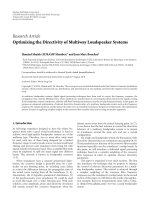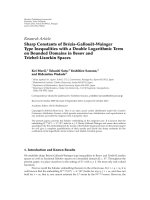Báo cáo hóa học: " Research Article Sharp Integral Inequalities Involving High-Order Partial Derivatives" ppt
Bạn đang xem bản rút gọn của tài liệu. Xem và tải ngay bản đầy đủ của tài liệu tại đây (498.74 KB, 10 trang )
Hindawi Publishing Corporation
Journal of Inequalities and Applications
Volume 2008, Article ID 571417, 10 pages
doi:10.1155/2008/571417
Research Article
Sharp Integral Inequalities Involving High-Order
Partial Derivatives
C J Zhao
1
and W S Cheung
2
1
Department of Information and Mathematics Sciences, College of Science, China Jiliang University,
Hangzhou 310018, China
2
Department of Mathematics, The University of Hong Kong, Pokfulam Road, Hong Kong
Correspondence should be addressed to C J Zhao,
Received 28 November 2007; Accepted 10 April 2008
Recommended by Peter Pang
The main purpose of the present paper is to establish some new sharp integral inequalities involving
higher-order partial derivatives. Our results in special cases yield some of the recent results on
Agarwal, Wirtinger, Poincar
´
e, Pachpatte, Smith, and Stredulinsky’s inequalities and provide some
new estimates on such types of inequalities.
Copyright q 2008 C J Zhao and W S Cheung. This is an open access article distributed under
the Creative Commons Attribution License, which permits unrestricted use, distribution, and
reproduction in any medium, provided the original work is properly cited.
1. Introduction
Inequalities involving functions of n independent variables, their partial derivatives, integrals
play a fundamental role in establishing the existence and uniqueness of initial and boundary
value problems for ordinary and partial differential equations as well as difference equations
1–10. Especially, in view of wider applications, inequalities due to Agarwal, Opial, Pachpatte,
Wirtinger, Poincar
´
e and et al. have been generalized and sharpened from the very day of their
discover. As a matter of fact, these now have become research topic in their own right 11–14.
In the present paper, we will use the same method of Agarwal and Sheng 15, establish some
new estimates on these types of inequalities involving higher-order partial derivatives. We
further generalize these inequalities which lead to result sharper than those currently available.
An important characteristic of our results is that the constant in the inequalities are explicit.
2. Main results
Let R be the set of real numbers and R
n
the n-dimensional Euclidean space. Let E, E
be a bounded domain in R
n
defined by E × E
n
i1
a
i
,b
i
× c
i
,d
i
,i 1, ,n.For
x
i
,y
i
∈ R, i 1, ,n, x, yx
1
, ,x
n
,y
1
, ,y
n
is a variable point in E × E
and
2 Journal of Inequalities and Applications
dxdy dx
1
···dx
n
dy
1
···dy
n
. For any continuous real-valued function ux, y defined on
E × E
,wedenoteby
E
E
ux, ydxdy the 2n-fold integral
b
1
a
1
···
b
n
a
n
d
1
c
1
···
d
n
c
n
u
x
1
, ,x
n
,y
1
, ,y
n
dx
1
···dx
n
dy
1
···dy
n
, 2.1
and for any x, y ∈ E × E
,
Ex
E
x
us, tdsdt is the 2n-fold integral
x
1
a
1
···
x
n
a
n
y
1
c
1
···
y
n
c
n
u
s
1
, ,s
n
,t
1
, ,t
n
dx
1
···ds
n
dt
1
···dt
n
. 2.2
We represent by FE × E
the class of continuous functions ux, y : E × E
→ R for which
D
2n
ux, yD
1
···D
2n
ux, y,where
D
1
∂
∂x
1
, ,D
n
∂
∂x
n
,D
n1
∂
∂y
1
, ,D
2n
∂
∂y
n
2.3
existsandthatforeachi,1≤ i ≤ n,
ux, y
x
i
a
i
0,ux, y
y
i
c
i
0,ux, y
x
i
b
i
0,ux, y
y
i
d
i
0, i 1, ,n
2.4
the class FE × E
is denoted as GE × E
.
Theorem 2.1. Let μ ≥ 0,λ ≥ 1 be given real numbers, and let px, y ≥ 0, x, y ∈ E × E
be a
continuous function. Further, let ux, y ∈ GE × E
. Then, the following inequality holds
E
E
px, y
ux, y
μ
dx dy
≤
E
E
px, yqx, y, λ, μdx dy
E
E
D
2n
ux, y
λ
dx dy
μ/λ
,
2.5
where
qx, y, λ, μ
1
2
n1
n
i1
x
i
− a
i
b
i
− x
i
y
i
− c
i
d
i
− y
i
λ−1/2
μ/λ
. 2.6
Proof. For the set {1, ,n},letπ A ∪ B, π
A
∪ B
be partitions, where A j
1
, ,j
k
,B
j
k1
, ,j
n
,A
i
1
, ,i
k
, and B
i
k1
, ,i
n
are such that card A card A
k and
card B card B
n − k, 0 ≤ k ≤ n. It is clear that there are 2
n1
such partitions. The set
of all such partitions we will denote as Z and Z
, respectively. For fixed partition π, π
and
x ∈ E, y ∈ E
, we define
E
π
x
E
π
y
us, tds dt
Ax
Bx
A
y
B
y
us, tds dt, 2.7
C J Zhao and W S Cheung 3
where
Ax
,
A
y
denote the k-fold integral,
Bx
,
B
y
represent the n − k-fold integral. Thus
from the assumptions it is clear that for each π ∈ Z, π
∈ Z
ux, y
≤
E
π
x
E
π
y
D
2n
us, t
ds dt. 2.8
In view of H
¨
older integral inequality, we have
ux, y
≤
i∈A
x
i
− a
i
i∈B
b
i
− x
i
i∈A
y
i
− c
i
i∈B
d
i
− y
i
λ−1/λ
×
E
π
x
E
π
y
D
2n
us, t
λ
ds dt
1/λ
.
2.9
A multiplication of these 2
n1
inequalities and an application of the Arithmetic-Geometric
mean inequality give
ux, y
μ
≤
n
i1
x
i
− a
i
b
i
− x
i
y
i
− c
i
d
i
− y
i
λ−1/2
μ/λ
×
π∈Z, π
∈Z
E
π
x
E
π
y
D
2n
us, t
λ
ds dt
1/2
n1
μ/λ
≤
1
2
n1
n
i1
x
i
− a
i
b
i
− x
i
y
i
− c
i
d
i
− y
i
λ−1/2
μ/λ
×
π∈Z, π
∈Z
E
π
x
E
π
y
D
2n
us, t
λ
ds dt
μ/λ
qx, y, λ, μ
E
E
D
2n
us, t
λ
ds dt
μ/λ
.
2.10
Now, multiplying both the sides of 2.10 by px, y and integrating the resulting inequality on
E × E
,wehave
E
E
px, y
ux, y
μ
dx dy ≤
E
E
px, yqx, y, λ, μdx dy
E
E
D
2n
us, t
λ
ds dt
μ/λ
,
2.11
where
qx, y, λ, μ
1
2
n1
n
i1
x
i
− a
i
b
i
− x
i
y
i
− c
i
d
i
− y
i
λ−1/2
μ/λ
. 2.12
Remark 2.2. Taking for px, y1in2.5, 2.5 reduces to
E
E
ux, y
μ
dx dy ≤ K
0
E
E
D
2n
ux, y
λ
dx dy
μ/λ
, 2.13
where
K
0
1
2
μ/λ
B
2
1
μ
2
−
μ
2λ
, 1
μ
2
−
μ
2λ
n
n
i1
b
i
− a
i
d
i
− c
i
1μ−μ/λ
, 2.14
and B is the Beta function.
4 Journal of Inequalities and Applications
Taking for λ μ 2in2.13 reduces to
E
E
ux, y
2
dx dy ≤
π
2
8
n
M
2
E
E
D
2n
ux, y
2
dx dy
, 2.15
where
M
n
i1
b
i
− a
i
d
i
− c
i
4
. 2.16
Let ux, y reduce to ux in 2.15 and with suitable modifications, then 2.15 becomes the
following two Wirting type inequalities:
E
ux
2
dx ≤
π
4
n
M
2
E
D
n
ux
2
dx
, 2.17
where
M
n
i1
b
i
− a
i
2
. 2.18
Similarly
E
ux
4
dx ≤
3π
16
n
M
4
E
D
n
ux
4
dx
, 2.19
where M is as in 2.17.
For n 2, the inequalities 2.17 and 2.19 have been obtained by Smith and
Stredulinsky 16, however, with the right-hand sides, respectively, multiplies 4/π
2
and
16/3π
4
. Hence, it is clear that inequalities 2.17 and 2.19 are more strengthed.
Remark 2.3. Let ux, y reduce to ux in 2.5 and with suitable modifications, then 2.5
becomes the following result:
E
px
ux
μ
dx ≤
E
pxqx, λ, μdx
E
D
n
ux
λ
dx
μ/λ
, 2.20
where
qx, λ, μ
1
2
n
n
i1
x − a
i
b
i
− x
i
λ−1/2
μ/λ
. 2.21
This is just a new result which was given by Agarwal and Sheng 15.
Theorem 2.4. Let px, y ≥ 0, x, y ∈ E × E
be a continuous function. Further, let for k
1, ,r, μ
k
≥ 0,λ
k
≥ 1, be given real numbers such that
r
k1
μ
k
/λ
k
1,andu
k
x, y ∈ GE × E
.
Then the following inequality holds
E
E
px, y
r
k1
u
k
x, y
μ
k
dx dy
≤
E
E
px, y
r
k1
q
x, y, λ
k
,μ
k
dx dy
r
k1
μ
k
λ
k
E
E
D
2n
u
k
x, y
λ
k
dx dy.
2.22
C J Zhao and W S Cheung 5
Proof. Setting μ μ
k
,λ λ
k
and ux, yu
k
x, y,1≤ k ≤ r in 2.10, multiplying the r
inequalities, and applying the extended Arithmetic-Geometric means inequality,
r
k1
a
μ
k
/λ
k
k
≤
r
k1
μ
k
λ
k
a
k
,a
k
≥ 0, 2.23
to obtain
r
k1
u
k
x, y
μ
k
≤
r
k1
q
x, y, λ
k
,μ
k
E
E
D
2n
u
k
s, t
λ
k
ds dt
μ
k
/λ
k
≤
r
k1
q
x, y, λ
k
,μ
k
r
k1
μ
k
λ
k
E
E
D
2n
u
k
s, t
λ
k
ds dt.
2.24
Now multiplying both sides of 2.24 by px, y and then integrating over E × E
, we obtain
2.22.
Corollary 2.5. Let the conditions of Theorem 2.4 be satisfied. Then the following inequality holds
E
E
px, y
r
k1
u
k
x, y
μ
k
dx dy < K
1
E
E
px, ydx dy
r
k1
μ
k
λ
k
E
E
D
2n
u
k
x, y
λ
k
dx dy,
2.25
where
K
1
1
2
n1
r
k1
μ
k
n
i1
b
i
− a
i
b
i
− a
i
−1
r
k1
μ
k
. 2.26
This is just a general form of the following inequality which was established by Agarwal
and Sheng 15:
E
px
r
k1
u
k
x
μ
k
dx < K
1
E
pxdx
r
k1
μ
k
λ
k
E
D
n
u
k
x
λ
k
dx, 2.27
where
K
1
1
2
n
r
k1
μ
k
n
i1
b
i
− a
i
−1
r
k1
μ
k
. 2.28
Remark 2.6. For px, y1, the inequality 2.22 becomes
E
E
r
k1
u
k
x, y
μ
k
dx dy ≤ K
2
r
k1
μ
k
λ
k
E
E
D
2n
u
k
x, y
λ
k
dx dy, 2.29
where
K
2
1
2
B
2
1
r
k1
μ
k
2
,
1
r
k1
μ
k
2
n
n
i1
b
i
− a
i
d
i
− c
i
r
k1
μ
k
. 2.30
For ux, yux, the inequality 2.29 has been obtained by Agarwal and Sheng 15.
6 Journal of Inequalities and Applications
Theorem 2.7. Let λ and ux, y be as in Theorem 2.1, μ ≥ 1 be a given real number. Then the following
inequality holds
E
E
ux, y
λ
dx dy ≤ K
3
λ, μ
E
E
grad ux, y
λ
μ
dx dy, 2.31
where
K
3
λ, μ
1
2n
B
2
λ 1
2
,
λ 1
2
K
λ
μ
n
i1
b
i
− a
i
d
i
− c
i
λ/n
,
grad ux, y
μ
n
i1
∂
2
∂x
i
∂y
i
ux, y
μ
1/μ
,
2.32
and where Kλ/μ1 if λ ≥ μ,andKλ/μn
1−λ/μ
if 0 ≤ λ/μ ≤ 1.
Proof. For each fixed i,1≤ i ≤ n, in view of
ux, y
x
i
a
i
0,ux, y
y
i
c
i
0,ux, y
x
i
b
i
0,ux, y
y
i
d
i
0, i 1, ,n,
2.33
we have
ux, y
x
i
a
i
y
i
c
i
∂
2
∂s
i
∂t
i
u
x, y; s
i
,t
i
ds
i
dt
i
,
ux, y
b
i
x
i
d
i
y
i
∂
2
∂s
i
∂t
i
u
x, y; s
i
,t
i
ds
i
dt
i
,
2.34
where
u
x, y; s
i
,t
i
u
x
1
, ,x
i−1
,s
i
,x
i1
, ,x
n
,y
1
, ,y
i−1
,t
i
,y
i1
, ,y
n
. 2.35
Hence from H
¨
older inequality with indices λ and λ/1 − λ, it follows that
ux, y
λ
≤
x
i
− a
i
y
i
− d
i
λ−1
x
i
a
i
y
i
c
i
∂
2
∂s
i
∂t
i
u
x, y; s
i
,t
i
λ
ds
i
dt
i
,
ux, y
λ
≤
b
i
− x
i
d
i
− y
i
λ−1
b
i
x
i
d
i
y
i
∂
2
∂s
i
∂t
i
u
x, y; s
i
,t
i
λ
ds
i
dt
i
.
2.36
Multiplying 2.36, and then applying the Arithmetic-Geometric means inequality, to obtain
ux, y
λ
≤
1
2
x
i
− a
i
y
i
− c
i
b
i
− x
i
d
i
− y
i
λ−1/2
×
b
i
a
i
d
i
c
i
∂
2
∂s
i
∂t
i
u
x, y; s
i
,t
i
λ
ds
i
dt
i
,
2.37
and now integrating 2.37 on E × E
, we arrive at
E
E
ux, y
λ
dx dy ≤
b
i
a
i
d
i
c
i
1
2
x
i
− a
i
y
i
− c
i
b
i
− x
i
d
i
− y
i
λ−1/2
dx
i
dy
i
×
E
E
∂
2
∂x
i
∂y
i
ux, y
λ
dx dy.
2.38
C J Zhao and W S Cheung 7
Next, multiplying the inequality 2.38 for 1 ≤ i ≤ n, and using the Arithmetic-Geometric
means inequality, and in view of the following inequality:
n
i1
a
α
i
≤ Kα
n
i1
a
i
α
,a
i
> 0, 2.39
where Kα1ifα ≥ 1, and Kαn
1−α
if 0 ≤ α ≤ 1, we get
E
E
ux, y
λ
dx dy ≤
n
i1
b
i
a
i
d
i
c
i
1
2
x
i
− a
i
y
i
− c
i
b
i
− x
i
d
i
− y
i
λ−1/2
dx
i
dy
i
1/n
×
n
i1
E
E
∂
2
∂x
i
∂y
i
ux, y
λ
dx dy
1/n
≤
1
2n
n
i1
b
i
a
i
d
i
c
i
1
2
x
i
− a
i
y
i
− c
i
b
i
− x
i
d
i
− y
i
λ−1/2
dx
i
dy
i
1/n
×
n
i1
E
E
∂
2
∂x
i
∂y
i
ux, y
λ
dx dy
≤
1
2n
B
2
λ 1
2
,
λ 1
2
n
i1
b
i
− a
i
d
i
− c
i
λ/n
×
E
E
grad ux, y
λ
λ
dx dy,
≤ K
3
λ, μ
E
E
grad ux, y
λ
μ
dx dy,
2.40
where
K
3
λ, μ
1
2n
B
2
λ 1
2
,
λ 1
2
K
λ
μ
n
i1
b
i
− a
i
d
i
− c
i
λ/n
,
grad ux, y
μ
n
i1
∂
2
∂x
i
∂y
i
ux, y
μ
1/μ
,
2.41
and where Kλ/μ1ifλ ≥ μ,andKλ/μn
1−λ/μ
if 0 ≤ λ/μ ≤ 1.
Remark 2.8. Let ux, y reduce to ux in 2.31 and with suitable modifications, and let λ ≥ 2,
μ 2, then 2.31 becomes
E
ux
λ
dx ≤ K
3
λ, 2
E
grad ux
λ
μ
dx. 2.42
This is just a better inequality than the following inequality which was given by Pachpatte 17
E
ux
λ
dx ≤
1
n
β
2
λ
E
grad ux
λ
μ
dx. 2.43
Because for λ ≥ 2, it is clear that K
3
λ, 2 < 1/nβ/2
λ
,whereβ max
1≤i≤n
b
i
− a
i
.
8 Journal of Inequalities and Applications
On the other hand, taking for μ 2,λ 2orμ 2,λ 4in2.31 and let ux, y reduce
to ux with suitable modifications, it follows the following Poincar
´
e-type inequalities:
E
ux
2
dx ≤
π
16n
β
2
E
grad ux
2
2
dx,
E
ux
4
dx ≤
3π
256n
β
4
E
grad ux
4
2
dx.
2.44
The inequalities 2.44 have been discussed in 18 with the right-hand sides, respectively,
multiplied by 4/π and 16/3π. Hence inequalities 2.44 are more strong results on these types
of inequalities.
If μ ≥ λ, in the right sides of 2.31 we can apply H
¨
older inequality with indices μ/λ and
μ/μ − λ, to obtain the following corollary.
Corollary 2.9. Let the conditions of Theorem 2.7 be satisfied and μ ≥ λ.Then
E
E
ux, y
λ
dx dy ≤ K
4
λ, μ
E
E
grad ux, y
μ
μ
dx dy
λ/μ
, 2.45
where
K
4
λ, μK
3
λ, μ
n
i1
b
i
− a
i
d
i
− c
i
μ−λ/μ
. 2.46
Remark 2.10. Taking ux, yux and with suitable modifications, the inequality 2.45
reduces to the following result which was given by Agarwal and Sheng 15:
E
ux
λ
dx ≤ K
6
λ, μ
E
grad ux
μ
μ
dx
λ/μ
, 2.47
where
K
6
λ, μK
5
λ, μ
n
i1
b
i
− a
i
μ−λ/μ
,
K
5
λ, μ
1
2n
B
1 λ
2
,
1 λ
2
K
λ
μ
n
i1
b
i
− a
i
λ/n
,
2.48
and Kλ/μ is as in Theorem 2.7.
Taking λ 1, μ 2 the inequality 2.45, 2.45 reduces to
E
E
ux, y
dx dy
2
≤ K
4
1, 2
E
E
grad ux, y
2
2
dx dy. 2.49
This is just a general form of the following inequality which was given by Agarwal and Sheng
15.
E
ux
dx
2
≤
K
6
1, 2
2
E
grad ux
2
2
dx dy. 2.50
Similar to the proof of Theorem 2.7, we have the following theorem.
C J Zhao and W S Cheung 9
Theorem 2.11. For u
k
x, y ∈ GE × E
, μ
k
≥ 1, 1 ≤ k ≤ r. Then the following inequality holds
E
E
n
i1
u
k
x, y
μ
k
1/r
dx dy ≤ K
5
E
E
r
k1
grad u
k
x, y
μ
k
μ
k
dx dy, 2.51
where
K
5
1
2nr
B
2
1 1/r
r
k1
μ
k
2
,
1 1/r
r
k1
μ
k
2
n
i1
b
i
− a
i
d
i
− c
i
r
k1
μ
k
/nr
. 2.52
Remark 2.12. Taking ux, yux and with suitable modifications, the inequality 2.51
reduces to the following result:
E
n
i1
u
k
x
μ
k
1/r
dx ≤ K
9
E
r
k1
grad ux
μ
k
μ
k
dx, 2.53
where
K
9
1
2nr
B
1 1/r
r
k1
μ
k
2
,
1 1/r
r
k1
μ
k
2
n
i1
b
i
− a
i
r
k1
μ
k
/nr
. 2.54
In 19, Pachpatte proved the inequality 2.53 for μ
k
≥ 2, 1 ≤ k ≤ r with K
9
replaced by
1/nrβ/2
r
k1
μ
k
/r
, where β is as in Remark 2.8. It is clear that K
9
< 1/nrβ/2
r
k1
μ
k
/r
, and
hence 2.53 is a better inequality than a result of Pachpatte.
Similarly, all other results in 15 also can be generalized by the same way. Here, we omit
the details.
Acknowledgments
Research is supported by Zhejiang Provincial Natural Science Foundation of ChinaY605065,
Foundation of the Education Department of Zhejiang Province of China 20050392. Research
is partially supported by the Research Grants Council of the Hong Kong SAR, China Project
No.:HKU7016/07P.
References
1 R. P. Agarwal and P. Y. H. Pang, Opial Inequalities with Applications in Differential and Difference
Equations, vol. 320 of Mathematics and Its Applications, Kluwer Academic Publishers, Dordrecht, The
Netherlands, 1995.
2 R. P. Agarwal and V. Lakshmikantham, Uniqueness and Nonuniqueness Criteria for Ordinary Differential
Equations,vol.6ofSeries in Real Analysis, World Scientific, Singapore, 1993.
3 R. P. Agarwal and E. Thandapani, “On some new integro-differential inequalities,” Analele S¸tiint¸ifice
ale Universit
˘
at¸ii “Al. I. Cuza” din Ias¸i, vol. 28, no. 1, pp. 123–126, 1982.
4 D. Ba
˘
ınov and P. Simeonov, Integral Inequalities and Applications,vol.57ofMathematics and Its
Applications, Kluwer Academic Publishers, Dordrecht, The Netherlands, 1992.
5 J. D. Li, “Opial-type integral inequalities involving several higher order derivatives,” Journal of
Mathematical Analysis and Applications, vol. 167, no. 1, pp. 98–110, 1992.
6 D. S. Mitrinovi
ˇ
c, J. E. Pe
ˇ
cari
´
c, and A. M. Fink, Inequalities Involving Functions and Their Integrals ang
Derivatives, Kluwer Academic Publishers, Dordrecht, The Netherlands, 1991.
10 Journal of Inequalities and Applications
7 W S. Cheung, “On Opial-type inequalities in two variables,” Aequationes Mathematicae, vol. 38, no. 2-3,
pp. 236–244, 1989.
8 W S. Cheung, “Some new Opial-type inequalities,” Mathematika, vol. 37, no. 1, pp. 136–142, 1990.
9 W S. Cheung, “Some generalized Opial-type inequalities,” Journal of Mathematical Analysis and
Applications, vol. 162, no. 2, pp. 317–321, 1991.
10 W S. Cheung, “Opial-type inequalities with m functions in n variables,” Mathematika, vol. 39, no. 2,
pp. 319–326, 1992.
11 P. S. Crooke, “On two inequalities of Sobolev type,” Applicable Analysis, vol. 3, no. 4, pp. 345–358,
1974.
12 B. G. Pachpatte, “Opial type inequality in several variables,” Tamkang Journal of Mathematics, vol. 22,
no. 1, pp. 7–11, 1991.
13 B. G. Pachpatte, “On some new integral inequalities in two independent variables,” Journal of
Mathematical Analysis and Applications, vol. 129, no. 2, pp. 375–382, 1988.
14 X J. Wang, “Sharp constant in a Sobolev inequality,” Nonlinear Analysis: Theory, Methods & Application,
vol. 20, no. 3, pp. 261–268, 1993.
15 R. P. Agarwal and Q. Sheng, “Sharp integral inequalities in n independent variables,” Nonlinear
Analysis: Theory, Methods & Applications, vol. 26, no. 2, pp. 179–210, 1996.
16 P. D. Smith and E. W. Stredulinsky, “Nonlinear elliptic systems with certain unbounded coefficients,”
Communications on Pure and Applied Mathematics, vol. 37, no. 4, pp. 495–510, 1984.
17 B. G. Pachpatte, “A note on Poincar
´
e and Sobolev type integral inequalities,” Tamkang Journal of
Mathematics, vol. 18, no. 1, pp. 1–7, 1987.
18 B. G. Pachpatte, “On multidimensional integral inequalities involving three functions,” Soochow
Journal of Mathematics, vol. 12, pp. 67–78, 1986.
19 B. G. Pachpatte, “On Sobolev type integral inequalities,” Proceedings of the Royal Society of Edinburgh A,
vol. 103, no. 1-2, pp. 1–14, 1986.

